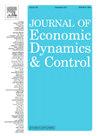On automation, labor reallocation and welfare
IF 2.3
3区 经济学
Q2 ECONOMICS
引用次数: 0
Abstract
We develop an open-economy model of endogenous automation with heterogeneous firms and labor-market reallocation to quantify the contribution of various trends to the adoption of robots in the U.S. economy. The decline in the relative price of robots is the major trend leading to automation, but interacts with other trends that either hinder (rising entry costs, rising markups) or slightly foster (rising labor productivity, declining trade costs) the adoption of robots. Taken alone, the decline in the relative price of robots produces moderate welfare gains in the long run, but less than labor productivity growth. We then exploit our model to show that a decline in the relative price of robots (i) generates small positive cross-country automation spillovers and (ii) produces inefficient labor-market reallocation since a small subsidy on robots combined with a training subsidy can generate small welfare gains. Our main conclusion is that automation can not be simply modeled as an exogenous decline in the price of robots, and must be analyzed in a broader framework taking into account trends affecting firms, such as the decline in business dynamism and the rise in markups.
在自动化、劳动力再分配和福利方面
我们开发了一个具有异质公司和劳动力市场再分配的内生自动化的开放经济模型,以量化各种趋势对美国经济中机器人采用的贡献。机器人相对价格的下降是导致自动化的主要趋势,但与其他趋势相互作用,这些趋势要么阻碍(进入成本上升,利润率上升),要么略微促进(劳动生产率提高,贸易成本下降)机器人的采用。单独来看,机器人相对价格的下降在长期内产生了适度的福利收益,但低于劳动生产率的增长。然后,我们利用我们的模型表明,机器人相对价格的下降(i)会产生小的正的跨国自动化溢出效应,(ii)会产生低效的劳动力市场再分配,因为对机器人的小额补贴加上培训补贴可以产生小的福利收益。我们的主要结论是,自动化不能简单地建模为机器人价格的外生下降,必须在更广泛的框架内进行分析,考虑到影响企业的趋势,如商业活力的下降和加成的上升。
本文章由计算机程序翻译,如有差异,请以英文原文为准。
求助全文
约1分钟内获得全文
求助全文
来源期刊

Journal of Economic Dynamics & Control
ECONOMICS-
CiteScore
3.10
自引率
10.50%
发文量
199
期刊介绍:
The journal provides an outlet for publication of research concerning all theoretical and empirical aspects of economic dynamics and control as well as the development and use of computational methods in economics and finance. Contributions regarding computational methods may include, but are not restricted to, artificial intelligence, databases, decision support systems, genetic algorithms, modelling languages, neural networks, numerical algorithms for optimization, control and equilibria, parallel computing and qualitative reasoning.
 求助内容:
求助内容: 应助结果提醒方式:
应助结果提醒方式:


